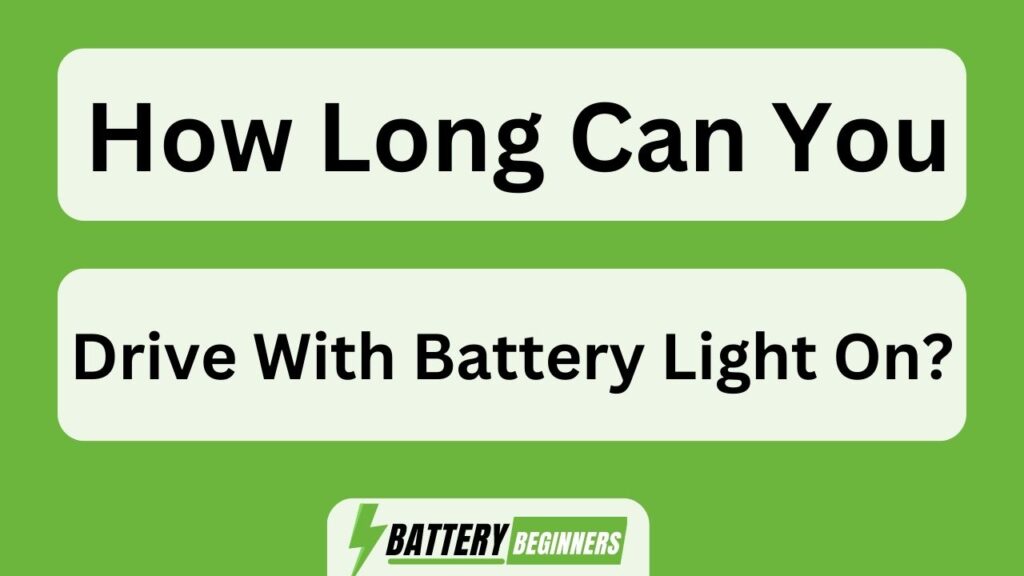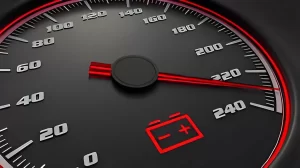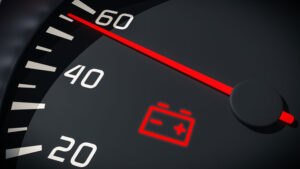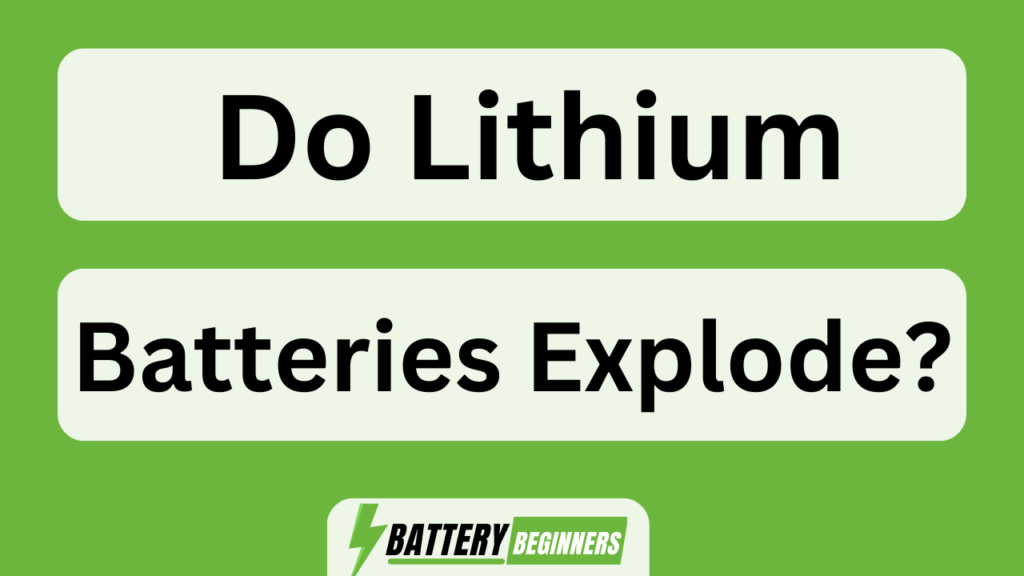Imagine you’re driving down the highway when suddenly, the battery light illuminates on your dashboard. What should you do?
How long can you continue driving before it becomes a serious issue?
In this article, we will explore the potential consequences of driving with the battery light on and discuss factors that can affect battery life.
By understanding the importance of addressing this issue promptly and seeking professional help when needed, you can ensure the longevity and reliability of your vehicle’s battery.
Key Takeaways How Long Can You Drive With Battery Light On?
- The battery light indicator should be taken seriously and any issues should be addressed promptly.
- Driving with the battery light on can result in damage to various components of the vehicle and put the driver and passengers at risk.
- Factors such as the age and condition of the battery, electrical system demands, and driving habits can affect battery life.
- It is important to assess the situation when the battery light is on and take immediate action, finding a safe place to pull over and address any underlying problems with the electrical system.
Understanding the Battery Light Indicator
You should be aware of the battery light indicator and what it means for your vehicle’s battery. It serves as a warning system, indicating potential issues with the battery or charging system. When the battery light illuminates on your dashboard, it is important to take it seriously and address the problem promptly.
The first step in assessing battery health is to check for signs of a failing battery, such as difficulty starting the engine or dimming headlights. These symptoms may indicate that the battery is not being properly charged by the alternator. Ignoring these warning signs and continuing to drive with the battery light on can have potential consequences for your vehicle’s electrical system and overall performance.
Therefore, it is crucial to address any issues indicated by the battery light without delay.
[Transition sentence: Understanding the potential consequences of driving with the battery light on…]
Potential Consequences of Driving with the Battery Light On
Ignoring the warning sign may lead to potential damages when driving with the battery light on. The battery light serves as an indicator of a problem with the charging system, which can have serious consequences if ignored. Continuing to drive with this warning light illuminated can result in potential damage to various components of the vehicle. It is important to understand that the battery not only provides power for starting the engine but also supplies electrical energy for essential systems such as lights, radio, and even safety features like airbags.
To illustrate the potential hazards of ignoring this warning, consider the following table:
| Potential Damage | Safety Hazards |
|---|---|
| Battery failure | Engine stalling |
| Alternator damage | Reduced visibility due to loss of lighting systems |
| Electrical system malfunction | Inability to operate safety features |
Driving without addressing these issues can put both the driver and passengers at risk. Therefore, it is crucial to promptly address any problems indicated by the battery light before further damage occurs. Transitioning into factors affecting battery life, one must consider various aspects that influence its lifespan.
[SUBSEQUENT SECTION: FACTORS AFFECTING BATTERY LIFE]
Factors Affecting Battery Life
The age and condition of a vehicle’s battery can have a significant impact on its overall lifespan. A well-maintained battery that is relatively new will typically last longer than an older, poorly maintained one. Additionally, the electrical system demands of the vehicle can also affect battery life, with high-powered accessories and frequent use putting more strain on the battery.
Driving habits and conditions can play a role in battery longevity, as excessive idling or short trips may not allow the battery to fully recharge.
In summary, factors such as the age and condition of the battery, electrical system demands, and driving habits and conditions all contribute to the overall lifespan of a vehicle’s battery. It is important to regularly maintain and inspect the battery to ensure optimal performance and prevent unexpected failures.
Age and condition of the battery
If your battery is old or in poor condition, you shouldn’t ignore the battery light. The age and condition of the battery can greatly affect its lifespan and health.
As a battery ages, it loses its ability to hold a charge and deliver sufficient power to start your vehicle. A weak or worn out battery may struggle to provide enough energy for the electrical system demands of your car, causing the battery light to come on.
Ignoring this warning sign could lead to further damage to your vehicle’s electrical system or leave you stranded with a dead battery. Therefore, it is crucial to address any issues with an aging or deteriorating battery promptly.
Transitioning into the subsequent section about electrical system demands, it is important to understand how these demands can impact the overall performance of your vehicle’s battery.
Electrical system demands
To ensure optimal performance of your vehicle, it’s essential to be mindful of the demands placed on its electrical system. The electrical system of a vehicle is responsible for powering various components such as lights, radio, and air conditioning. Electric vehicle charging and battery drainage prevention are crucial aspects that need to be considered.
One way to prevent excessive battery drainage is by avoiding prolonged use of power-consuming features when the battery light is on. This includes minimizing the usage of headlights, interior lights, and other electrical accessories. Additionally, using energy-efficient settings for climate control can help conserve battery power.
To better understand how different electrical components impact the battery life, refer to the table below:
| Electrical Component | Power Consumption |
|---|---|
| Headlights | High |
| Air Conditioning | Moderate |
| Radio | Low |
By being mindful of these factors and adjusting your driving habits accordingly, you can help prolong the life of your vehicle’s battery. Transitioning into the subsequent section about ‘driving habits and conditions,’ it’s important to note that they also play a significant role in determining how long you can drive with the battery light on.
Driving habits and conditions
After discussing the electrical system demands, it is important to consider driving habits and conditions when determining how long one can drive with the battery light on.
Driving safety should be the primary concern in this situation. It is crucial to maintain a constant awareness of the vehicle’s performance and any changes in its behavior. This includes monitoring the engine temperature, listening for any unusual noises, and observing any decrease in power or acceleration.
Additionally, it is recommended to avoid using unnecessary electrical accessories such as heated seats or high-powered sound systems, as these can further strain the already weakened battery. Regular battery maintenance, such as checking for corrosion on terminals and ensuring proper connections, can also help prolong its lifespan.
By being mindful of these factors while driving with the battery light on, one can better assess the situation and make informed decisions about their next steps.
Assessing the Situation
When your battery light is on, you need to quickly assess the situation. Assessing urgency is crucial to determine the potential troubleshooting steps that need to be taken.
The first step is to gauge the level of urgency by considering factors such as the age of the battery, driving conditions, and the length of time since the light came on. If the battery is relatively new and you have been driving under normal conditions, there may be some time before taking immediate action becomes necessary. However, if the battery is old or you have been driving in extreme weather conditions, it is advisable to take immediate action.
Ignoring a warning sign like a battery light can lead to further damage and potentially leave you stranded on the road. Therefore, it is important not to delay addressing this issue and promptly find a safe place to pull over and address any underlying problems with your vehicle’s electrical system.
Taking Immediate Action
First, assess the urgency of the situation by considering factors such as the age of your battery, driving conditions, and how long it’s been since the light came on.
- Check the age of your battery: Older batteries are more likely to lose their charge quickly.
- Evaluate driving conditions: If you are driving in extreme weather or heavy traffic, your battery may drain faster.
- Determine when the light came on: If it just turned on, you may have more time than if it has been on for a while.
Ignoring the battery light can lead to potential dangers such as sudden loss of power and being stranded. It is important to take immediate action. While there are temporary fixes like turning off non-essential electrical components and reducing unnecessary stops, these should only be relied upon for a short period of time.
Transitioning into the subsequent section about ‘temporary solutions and precautions’, it is crucial to address this issue promptly to prevent further complications.
Temporary Solutions and Precautions
One option to address the issue is by temporarily reducing the use of unnecessary electrical components. This can help conserve battery power and extend the driving time before the battery completely drains. In addition, there are some troubleshooting steps that can be taken to identify and potentially resolve any underlying issues causing the battery light to come on. These include checking for loose or corroded connections, inspecting the drive belt for any signs of damage, and ensuring that the alternator is functioning properly. However, it’s important to note that these temporary fixes are just that – temporary. It’s crucial to address the issue promptly as driving with a malfunctioning charging system can cause further damage to your vehicle’s electrical components and leave you stranded on the road.
Transition: Addressing this issue promptly will not only prevent further damage but also ensure a safe driving experience in the long run.
The Importance of Addressing the Issue Promptly
Addressing the issue of a battery light promptly is essential due to the potential damage it can cause to other car components. Ignoring the warning signs and continuing to drive with the battery light on can lead to an increased risk of a complete breakdown, leaving the driver stranded on the road.
Furthermore, neglecting the issue for an extended period can result in long-term consequences. These consequences can include permanent damage to the electrical system or even engine failure.
Potential damage to other car components
Additionally, driving with the battery light on could potentially cause damage to other car components.
The potential damage to the engine is a major concern when the battery light is illuminated. Without a properly functioning battery, the engine may not receive enough power to run efficiently, leading to increased wear and tear on its internal components. This can result in decreased performance and even engine failure if left unaddressed.
Furthermore, the electrical system of the vehicle can also be negatively affected by driving with the battery light on. The lack of sufficient power from the battery can disrupt various electrical functions such as lights, radio, and even safety features like airbags.
It is crucial to address this issue promptly in order to prevent further damage and ensure optimal performance of your vehicle’s systems. This potential harm highlights an increased risk of a complete breakdown if not addressed immediately.
Increased risk of a complete breakdown
Be aware that driving with the battery light on could lead to a complete breakdown if not addressed promptly. Ignoring this warning sign can result in severe risks and dangers for both the driver and the vehicle. Here are some signs of a failing battery that should not be ignored:
- Dimming headlights: If you notice your headlights becoming noticeably dimmer, it could indicate a problem with your battery.
- Difficulty starting the engine: A struggling or slow start could be a sign that your battery is losing its charge.
- Electrical issues: Malfunctioning power windows, radio, or other electrical components may be caused by a failing battery.
- Stalling engine: If your engine stalls while driving, it could signal a complete loss of power.
Driving with these symptoms increases the chances of experiencing a complete breakdown. Neglecting the issue may lead to long-term consequences such as damage to other car components.
Long-term consequences of neglecting the issue
Neglecting the issue of a battery light being on in a vehicle can have long-term consequences that extend beyond the immediate risk of a complete breakdown. Apart from the potential safety hazards associated with being stranded on the road, there are other significant concerns to consider.
Continuing to drive with a battery light illuminated can lead to a gradual decline in vehicle performance. The electrical system may become compromised, resulting in issues such as dimming headlights, malfunctioning power windows, and even stalling while driving. Moreover, neglecting this problem for an extended period could cause damage to other vital components of the vehicle’s electrical system, leading to costly repairs.
It is crucial to address this issue promptly by seeking professional help before more severe problems arise. Transitioning into the subsequent section about ‘seeking professional help,’ it is essential to understand the necessary steps to take when facing a persistent battery light indication.
Seeking Professional Help
Visiting a mechanic or auto service center is crucial when seeking professional help for an issue with the battery light.
It is important to have the underlying problem diagnosed and repaired accurately by a trained technician who can identify potential issues such as a faulty alternator, loose connections, or a failing battery.
If necessary, the mechanic may suggest replacing the battery to ensure optimal performance and prevent further complications.
Visiting a mechanic or auto service center
When your battery light is on, you should consider taking your vehicle to a mechanic or auto service center. These professionals possess the expertise and tools required to diagnose and repair the underlying problem effectively.
- Peace of mind: By visiting a professional, you can rest assured that your vehicle is in capable hands.
- Preventive maintenance: Regular maintenance checks can help detect issues early on, potentially saving you from costly repairs down the line.
- Expert diagnosis: Mechanics have access to specialized diagnostic equipment that enables them to accurately identify the root cause of the battery light being on.
- Quality repairs: Auto service centers use genuine parts and follow manufacturer guidelines to ensure high-quality repairs.
Regular maintenance not only prevents unexpected breakdowns but also helps prolong the life of your vehicle. Signs of a failing battery, such as dim headlights or difficulty starting the engine, should never be ignored. By seeking professional help promptly, you can address any potential issues and keep your vehicle running smoothly for years to come.
Diagnosing and repairing the underlying problem
To effectively diagnose and repair the underlying problem, it’s essential to rely on the expertise and diagnostic equipment available at a mechanic or auto service center.
When diagnosing common battery issues, mechanics will typically start by conducting a thorough inspection of the battery, checking for signs of a failing battery such as corrosion on the terminals, low electrolyte levels, or a swollen casing. They may also use specialized tools to test the voltage and load capacity of the battery.
In addition, they will examine other components of the charging system including the alternator and voltage regulator to ensure they are functioning properly. By identifying and addressing these issues promptly, mechanics can prevent further damage to the vehicle’s electrical system.
Transitioning into replacing the battery if necessary allows for a comprehensive approach to resolving any potential problems.
Replacing the battery if necessary
If the mechanic determines that it is necessary, they will replace the battery. Before replacing the battery, however, they should explore other recharging options to ensure that the battery is truly at fault.
This can involve using a battery charger or jump-starting the vehicle. Signs of a failing battery may include slow cranking, dim headlights, and a check engine light. It’s important to note that these signs can also indicate other issues with the vehicle’s electrical system, so proper diagnosis is crucial.
Once it has been confirmed that the battery needs replacement, it should be done promptly to avoid further damage to the vehicle’s electrical components.
Moving forward into preventive measures for battery health…
Preventive Measures for Battery Health
Battery health can be maintained through regular maintenance, avoiding excessive electrical demands, and keeping the battery terminals clean.
Regular maintenance includes checking the electrolyte level and topping it up if necessary, as well as inspecting the battery cables for any signs of damage or corrosion.
Additionally, it is important to avoid excessive electrical demands by minimizing the use of power-consuming accessories when the engine is not running.
Lastly, keeping the battery terminals clean by removing any buildup of dirt or corrosion helps ensure a good connection and prolongs battery life.
Regular battery maintenance
Regular battery maintenance is important to ensure optimal performance and prevent potential issues. This includes:
- Regularly checking the battery for signs of wear or damage, such as corrosion on the terminals or a swollen appearance.
- Keeping the battery clean and free from dirt or debris, as this can affect its ability to charge properly.
- Testing the battery’s voltage periodically to ensure it is within the recommended range.
By following these steps, drivers can identify any potential problems early on and take appropriate action before they become major issues.
It is also essential to avoid excessive electrical demands on the battery by:
- Minimizing the use of power-consuming accessories when not necessary.
This will help prolong the life of the battery and reduce strain on its capacity without compromising performance.
Avoiding excessive electrical demands
To maximize battery life and avoid potential issues with the electrical system, it is essential to be mindful of excessive electrical demands on your vehicle. Excessive use of power-consuming devices such as headlights, air conditioning, or audio systems can put a strain on the battery and shorten its lifespan.
Signs of a failing battery include dimming headlights, difficulty starting the engine, or a constant need for jump-starts. If you notice any of these signs or experience other electrical problems, it is crucial to address them promptly to prevent further damage to the battery and other components.
In the subsequent section about ‘keeping the battery terminals clean,’ proper maintenance techniques will be discussed to ensure optimal performance and longevity.
Keeping the battery terminals clean
Keeping the connections clean and free of dirt or corrosion will help ensure that the electrical system functions properly. Here are three important battery maintenance and troubleshooting techniques to keep in mind:
- Regularly inspect the battery terminals for any signs of corrosion or buildup. Use a wire brush or battery terminal cleaner to remove any dirt or corrosion that may be present.
- Apply a thin coat of petroleum jelly or dielectric grease to the battery terminals after cleaning them. This will help prevent future corrosion and ensure good electrical contact.
- Check the tightness of the battery terminals regularly, ensuring that they are securely fastened to prevent any loose connections.
By following these steps, you can maintain your battery’s performance and prolong its lifespan. With clean and well-maintained connections, your vehicle’s electrical system will operate efficiently, reducing the risk of a drained battery or other electrical issues.
Moving on to conclusion and final tips…
Conclusion and Final Tips
First of all, don’t panic if you see the battery light on while driving. It is important to address the issue promptly, but there are temporary fixes and alternative solutions that can help you continue driving safely.
If the battery light comes on, it indicates a problem with your vehicle’s charging system. One temporary fix is to turn off any unnecessary electrical components like the radio or air conditioning to reduce strain on the alternator.
Another alternative solution is to find a safe place to pull over and inspect the battery terminals for any corrosion or loose connections. Cleaning the terminals and tightening any loose connections may resolve the issue temporarily.
However, it is crucial to have your vehicle inspected by a professional as soon as possible to identify and fix the underlying cause of the battery light coming on.
Frequently Asked Questions
How do I know if my battery light indicator is malfunctioning?
To troubleshoot a malfunctioning battery light indicator, first check the connections and wiring for any damage or loose connections. Common causes include a faulty alternator, loose belt, or a bad battery.
Can driving with the battery light on damage other components of my car?
Driving with the battery light on can potentially cause alternator failure. If the battery light comes on while driving, it is crucial to address the issue immediately by checking the battery, alternator, and electrical connections.
Will using my car’s electrical features while the battery light is on drain the battery faster?
Using electrical features while the battery light is on can potentially drain the battery faster. The constant power draw from these features puts additional strain on an already compromised charging system, impacting overall battery life.
Can a dead battery be recharged if I drive with the battery light on for too long?
Driving with the battery light on for an extended period can lead to a dead battery. However, it is possible to recharge a dead battery by driving. Nevertheless, the consequences of driving with the battery light on should be considered.
Is it safe to continue driving with the battery light on if my car seems to be running fine otherwise?
Continuing to drive with the battery light indicator on, even if the car seems fine, is not safe. Ignoring this warning can lead to a dead battery and potential damage to other electrical components. It’s crucial to prioritize car maintenance and address the issue promptly.
Conclusion
In conclusion, driving with the battery light on can have serious consequences and should be addressed promptly.
Ignoring this warning indicator can lead to a complete breakdown of the vehicle and potential damage to other components.
Interestingly, studies show that approximately 40% of car breakdowns are due to battery-related issues. This statistic highlights the importance of regularly maintaining and addressing any battery-related concerns to ensure a smooth and safe driving experience.
Remember to seek professional help and implement preventive measures for optimal battery health.






